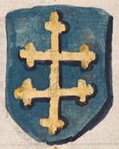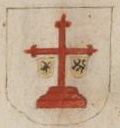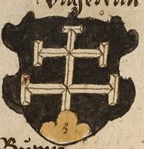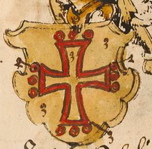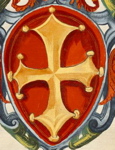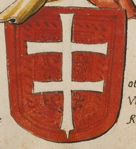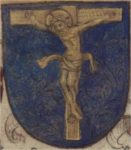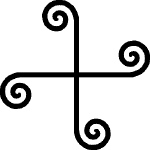|
treatment
|
characteristics
|
example emblazons
|
rulings and precedents
|
|
complex lines
|
The sides of the arms of the cross are not straight, but follow one
of the
complex
lines of division (wavy, indented, embattled, etc.) used in
period heraldry.
|

Argent, on a Latin cross couped floretty engrailed sable between
four birds azure an escallop Or.
BSB Cod.icon. 291, folio 42r
|

Argent, a cross raguly gules.
BSB Cod.icon. 291, folio 23v
|
"Some commenters questioned the use of a complex line on an
already complex cross. There is sufficient support for such a
treatment from period and post-period non-SCA arms. . .."
(October,
1995 LoAR)
"Ideally a cross indented would look like a cross of
lozenges, with a center
lozenge, two or three lozenges on the top arm and each side arm,
and three to five on the bottom arm, except that instead of just
touching at the corners the lozenges overlap a bit. (If the
lozenges only touch at the corners, then it's a cross of
lozenges/fusils or a cross fusilly.)"
(March,
2004 LoAR)
|
|
cotised
|
The cross is flanked at a small distance by thin lines that mirror
its shape.
|
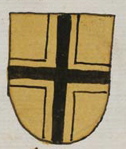
Or, a cross cotised sable.
from SGS Cod. Sang 1084, folio 27
|
|
For purposes of conflict-checking, cotises are treated as
secondary charges
(September,
2004 LoAR).
|
|
disjointed
|
The cross has been cut in half lengthwise and again widthwise,
forming four sections shaped like a letter "L".
|
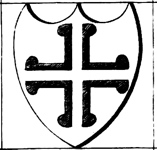
cross pomelly disjointed
Volume III of William Berry's 1828 Encyclopædia
Heraldica, Plate XXXVII
|

cross couped disjointed
Volume III of William Berry's 1828 Encyclopædia
Heraldica, Plate XXXIV
|
"Crosses disjointed are not considered equivalent to "on a cross,
a cross", since the ends of the cross disjointed are open, not
closed."
(May, 2011
LoAR)
"It should be noted that when charges are put on a cross moline
disjointed, they obscure the identifiability of the cross
somewhat;. . .Special care should be taken with the artwork to
preserve identifiability of all elements of the armory."
(April,
2002 LoAR)
"Crosses moline disjointed are period charges. Therefore, the
cross flory disjointed is no more than a single step from period
practice."
(May, 2011
LoAR)
|
|
dismembered
|
The limbs of the cross are disconnected from its center, and
sometimes additionally divided.
|

Latin cross couped dismembered
Volume III of William Berry's 1828 Encyclopædia
Heraldica, Plate XXXVII
|
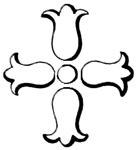
cross avellane dismembered
based on the image of a cross avellane on Plate XXXIII of Volume
III of William Berry's 1828 Encyclopædia Heraldica
|
There has been one registration of a cross
avellane dismembered, and none
of any other type that I could find.
|
|
elongated
|
Two limbs (those pointing up and down or those pointing left and
right) are longer than the other two.
Sometimes Latin crosses have also been
blazoned "elongated to base"
|

Or, a cross potent elongated palewise sable.
BSB Cod.icon. 390, folio 603
|
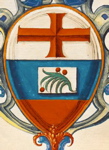
in chief: Argent, a cross couped elongated fesswise gules.
BSB Cod.icon. 270, folio 176r
|
A cross doubly pommeled
elongated palewise is not significantly different from a cross
moline
(February,
1997 LoAR).
|
|
fimbriated
|
A band of some contrasting tincture runs along the outside edges
of the charge.
|

Argent, a cross Or fimbriated between four crosses formy gules.
BSB Cod.icon. 309, folio 3r
|
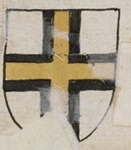
Argent, a cross Or fimbriated sable.
SGS Cod. Sang. 1084, folio 35
|
"Any charge that may be voided may be
fimbriated, and vice versa." To determine whether a charge may be
voided, "Start with a picture of the charge and make a photocopy
of it at 90% reduction. Cut the reduced copy out close to its
outer edge all the way around. Now place it on top of the original
picture. If the result looks like that charge voided, then that
charge is voidable; otherwise it is not."
(June,
2004 LoAR)
". . .[C]harges in overall charge groups will not be allowed to be
fimbriated after the September 2011 decision meetings."
(April,
2011 LoAR)
"Crosses flory may be both
voided and fimbriated. . .."
(December,
2009 LoAR)
A key cross is not simple enough to
void or fimbriate
(November,
1993 LoAR). However, "Since the voiding
is acceptable (and necessary) for a cross of
Toulouse, the somewhat
simpler cross clechy is also
voidable."
(December,
2007 LoAR)
"A cross formy
quadrate is simple enough to fimbriate. .
.Since a cross formy nowy is of equivalent
geometric complexity with a cross formy quadrate, it is also
simple enough to fimbriate."
(March,
2011 LoAR)
Neither a cross crosslet
(June,
2004 LoAR) nor a cross
bottony
(December,
1993 LoAR) can be voided in S.C.A.
heraldry.
A Cross of Jerusalem cannot be
fimbriated
(December,
1995 LoAR).
". . .a cross formy
fitched at the foot is too complicated
to fimbriate."
(November,
2009 LoAR)
"we would not register a cross/saltire
gringolé
voided (with the voiding being
gringolé as well)"
(December,
2004 LoAR)
An ordinary cross voided is not significantly different from an
ordinary cross parted and fretted
(March,
1994 LoAR).
|
|
fitchy
|
The bottom limb of the cross has been replaced with a spike.
|

Azure, a cross formy fitchy between four crowned heads proper.
BSB Cod.icon. 391, folio 243v
|
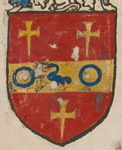
Gules, on a fess between three crosses formy fitchy Or a swan
between two annulets azure.
BSB Cod.icon. 291, folio 35v
|
"We note that a cross fitchy will automatically have a
longer bottom limb; it need not be blazoned as a
Latin cross."
(September,
2007 LoAR)
". . .the fitched limb should look like a smoothly tapering wedge,
not a freshly sharpened No.2 pencil"
(November,
2007 LoAR)
|
|
irradiated
|
emitting rays of light
|
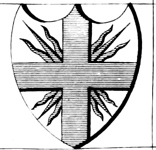
cross irradiated
Volume III of William Berry's 1828 Encyclopædia
Heraldica, Plate XXXII
|
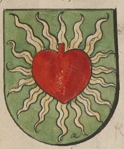
Vert, a human heart gules irradiated Or.
BSB Cod.icon. 391, folio 18v
|
"Irradiated charges, when drawn correctly, are a CD from
non-irradiated charges."
(November,
2003 LoAR).
|
|
Latin
In a few registrations such crosses are blazoned as "passion
crosses", and in some cases as "elongated to base".
Some early registrations also used the term "long crosses",
which has since fallen into disfavor.
|
The lower limb is longer than the other three.
|
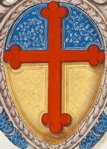
Or, a chief azure and overall a Latin cross bottony gules.
BSB Cod.icon. 267, folio 64r
|
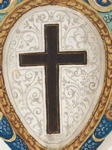
Argent, a Latin cross couped sable.
BSB Cod.icon. 267, folio 93r
|
The term "long" has been superceded by "Latin" for reasons of
"period usage and unambiguity".
(May,
2004 LoAR)
|
|

Azure, a wooden Latin cross couped argent.
BSB Cod.icon. 391, folio 26r
|
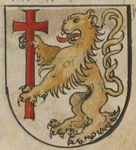
Argent, a lion salient Or maintaining a Latin cross gules.
BSB Cod.icon. 391, folio 10r
|
|
mossue
|
The limbs of the cross are rounded on the ends.
|
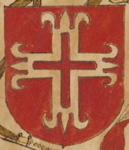
Gules, on a cross fleury argent a cross mossue gules.
BSB Cod.icon. 290, folio 135r
|
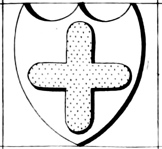
cross mossue
Volume III of William Berry's 1828 Encyclopædia
Heraldica, Plate XXXII
|
"Elvin, Parker, and Franklyn (Shield and Crest) all
treat mossue (which appears to be restricted in
mundane usage to the arms of crosses) as meaning 'rounded'."
(July,
1985 LoAR)
Note: Crosses with this treatment have a great deal in common with
some quatrefoils, as shown at left.
|
|

Or, on a chief gules three quatrefoils argent.
BSB Cod.icon. 274, folio 68r
|
|
|
nowy
|
a bulge, like a knot in a tree limb, at the intersection of the
arms of the cross
By default the bulge is circular, but it can also be
lozenge-shaped, in which case the cross is blazoned "nowy of a
lozenge", or square, in which case it's blazoned "nowy
quadrate" or occasionally just "quadrate".
There was one registration, in 1974, of a cross "quadrate by
estoile". On the
January,
2011 LoAR, it was reblazoned as simply "quadrate", though the
letter explains, ". . .the cross is not actually quadrate. The
'corners' are actually acute angles, and the whole somewhat
resembles the minor points we sometimes see on a compass star. The
cross, however, is functionally and heraldically equivalent to a
cross quadrate, and we have changed the blazon so that future
heralds are not confused by the old blazon."
"The term concave, as found in a few previous SCA
registrations, appears to apply to a cross that is somewhat nowy
lozengy (or nowy of a lozenge).. . .Because the blazon term
concave is not well-defined in real-world or SCA armory, it
should be avoided in the future."
(March,
2004 LoAR)
|
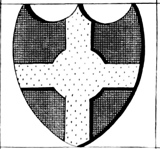
cross nowy
Volume III of William Berry's 1828 Encyclopædia
Heraldica, Plate XXXII
|
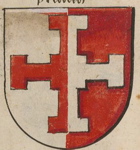
Per pale argent and gules, a cross potent nowy quadrate
counterchanged.
BSB Cod.icon. 391, folio 191v
|
". . .[W]e do not register crosses nowed of a lozenge. . .."
(March,
2012 LoAR)
"There is a step from period practice for the use of a cross
nowy," unless depicted as in The Accedence of Armorie,
"with projections in the middle of each arm, as opposed to the
center of the charge where the arms meet."
(April,
2016 LoAR,
cover
letter to the August, 2020 LoAR)
"We have no evidence of the nowy portion of a cross being further
modified by a complex line of division. We would like to see
period evidence of such treatment before we will register."
(July,
2001 LoAR)
"A cross quadrate must. . .be considered an artistic variant of
the underlying cross type, blazonable, but not significant for
purposes of conflict."
(September,
2009 LoAR) However, "The SCA has historically granted a CD for
a cross throughout versus a cross nowy or nowy quadrate."
(January,
2010 LoAR)
An ordinary cross nowy is simple enough to
fimbriate
(February,
2008 LoAR), as are an ordinary cross nowy quadrate
(July,
2005 LoAR), a cross
formy nowy quadrate
(July,
2004 LoAR), and a cross formy nowy
(March,
2011 LoAR).
An ordinary cross is significantly different from an ordinary
cross nowy
(July,
2003 LoAR) and from an ordinary cross nowy quadrate
(November,
2003 LoAR). An ordinary cross nowy is not significantly different
from an ordinary cross nowy quadrate
(September,
2000 LoAR).
A cross nowy has a distinct change from a
Celtic cross
(April,
2016 LoAR).
|
|

cross nowy of a lozenge
Volume III of William Berry's 1828 Encyclopædia
Heraldica, Plate XXXV
|

cross concave (as seen in S.C.A. registrations)
|
|
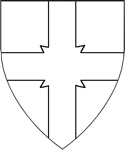
cross quadrate by estoile
|

????
BSB Cod.icon. 333, folio 33r
|
|
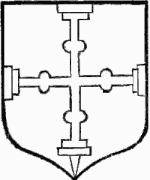
"a Croſſe nowye degraded fitche"
1597 edition of Gerard Legh's The Accedence of Armorie,
folio 35v
|
|
parted
|
The vertical and horizontal member are each split, lengthwise,
into two strips, and the strips are all conjoined.
If the cross is blazoned "treble parted" or
"tripartite", each member is split into three strips
instead of two.
|
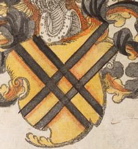
Or, a saltire parted sable.
BSB Cod.icon. 390, folio 115
|
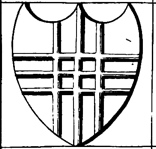
cross treble-parted
Volume III of William Berry's 1828 Encyclopædia
Heraldica, Plate XXXVI
|
". . .we grant no heraldic difference between a cross parted and
fretted and one voided. . ."
(March,
1995 LoAR) I would therefore expect no difference to be
granted between a cross parted and either a cross voided or a
cross parted and fretted.
|
|
parted and fretted
|
The vertical and horizontal member are each split, lengthwise,
into two strips, and the strips interlace where the members
overlap.
If the cross is blazoned "triple-parted and fretted" or
"triparted and fretted", each member is split into three
strips instead of two.
|

cross parted and fretted
Volume III of William Berry's 1828 Encyclopædia
Heraldica, Plate XXXII
|
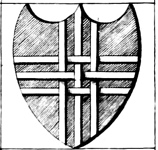
cross triple-parted and fretted
Volume III of William Berry's 1828 Encyclopædia
Heraldica, Plate XXXVII
|
". . .we grant no heraldic difference between a cross parted and
fretted and one voided. . ."
(March,
1995 LoAR)
There is one registration of a cross triple-parted and fretted in
which the center traits (i.e., the middle pallet and the middle
barrulet) are of a different tincture than the rest.
There has also been registered one
cross of four pallets fretted
with four barrulets, which is equivalent to an ordinary
cross quadruple-parted and fretted.
|
|
pierced
|
with a hole where the vertical and horizontal members overlap
When the hole takes up the entire area of overlap, the cross is
blazoned "quarter-pierced". When it is square but
does not take up the entire overlap, it's "square-pierced".
When the hole is lozenge-shaped, the cross is blazoned "pierced
of a lozenge". (I don't know whether this is a period
practice, but there are a couple of items registered 15-20 years
ago that reflect it.)
|
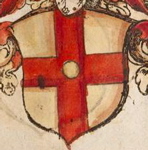
Or, a cross gules pierced.
BSB Cod.icon. 390, folio 612
|

Or, a cross azure quarter-pierced.
BSB Cod.icon. 270, folio 37r
|
"A cross quarter-pierced may also be blazoned as a cross
charged with a delf throughout,"
(October,
2003 LoAR). Because it is visually equivalent to adding a
tertiary charge, quarter-piercing can constitute a Clear
Difference
(October,
1992 LoAR).
A cross quarter-pierced drawn so that each arm is one-third the
width and height of the field must also be considered as a field
checky of nine parts when conflict checks are done
(August,
2004 LoAR).
|
|
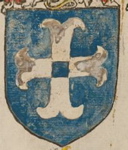
Azure, a cross moline square-pierced argent.
BSB Cod.icon. 291, folio 49v
|
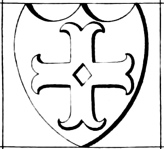
cross moline pierced of a lozenge
Volume III of William Berry's 1828 Encyclopædia
Heraldica, Plate XXXIII
|
|
throughout
|
reaching all the way to the edges of the field
|
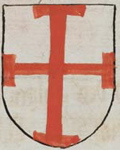
Argent, a cross potent throughout gules.
SGS Cod. Sang. 1084, folio 31
|
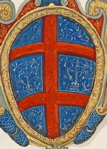
Azure, a doubled cross throughout gules.
BSB Cod.icon. 266, folio 169r
|
"A cross of any type should either be throughout on all arms or
not throughout on any of them."
(July,
2004 LoAR)
An ordinary cross is significantly different from a cross
formy throughout
(November,
2003 LoAR).
"While we give a CD for [an ordinary cross] versus a cross
couped, for most crosses
(such as crosses fleury) we
do not give such difference for couped versus throughout."
(February,
2002 LoAR).
A cross formy is
significantly different from a cross formy throughout
(May,
1997 LoAR).
|
|
voided
|
with an opening identical in shape to its outer edge through
which the tincture(s) behind it can be seen
A cross "voided per pale" is voided only along its vertical axis.
There has one registration of a cross "voided in the arms".
There's also been one of a cross "contrevoided", defined in
the
March,
1978 LoAR as having just its arms voided. The latter is
blazoned as "counter-voided" in the online O&A.
|
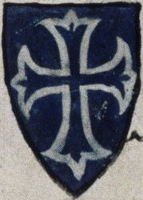
Azure, a cross fleury argent voided.
MS. Ashmole 804, pt. IV, fol. 11r
|

Gules, on a cross Or a cross bottony gules voided.
BSB Cod.icon. 391, folio 153r
|
"Start with a picture of the charge and make a photocopy of it at
90% reduction. Cut the reduced copy out close to its outer edge
all the way around. Now place it on top of the original picture.
If the result looks like that charge voided, then that charge is
voidable; otherwise it is not."
(June,
2004 LoAR)
"Any charge that may be voided may be
fimbriated, and vice versa."
(June,
2004 LoAR).
"We consider voiding to have the same visual weight as adding a
tertiary charge -- i.e. Sable, a cross Or voided gules and
Sable, a cross Or charged with another gules are
interchangeable blazons, yielding the same emblazon."
(cover
letter to the November, 1992 LoAR)
". . .we have examples of the simpler period crosses being voided
and then having some elaborate treatment applied to the ends. .
..What is not obvious is whether these were being treated as a
complex cross charged with a simpler one, or as a for-real
voiding. . ."
(December,
2004 LoAR) (I have included an example to the left, and made
my best guess as to how it would be blazoned if it is, in fact,
voided.)
Other charges cannot be positioned within a voided cross unless
evidence of that practice in period is found.
(January,
2015 LoAR)
"Crosses flory may be both
voided and fimbriated. . .."
(December,
2009 LoAR)
A key cross is not simple enough to
void or fimbriate
(November,
1993 LoAR). However, "Since the voiding is acceptable (and
necessary) for a cross of
Toulouse, the somewhat
simpler cross clechy is also
voidable."
(December,
2007 LoAR)
Neither a cross crosslet
(June,
2004 LoAR) nor a cross
bottony
(December,
1993 LoAR) can be voided in S.C.A. heraldry.
A Cross of Jerusalem cannot be
fimbriated
(December,
1995 LoAR).
". . .a cross formy
fitched at the foot is too complicated
to fimbriate."
(November,
2009 LoAR)
"we would not register a cross/saltire
gringolé voided
(with the voiding being gringolé as well)"
(December,
2004 LoAR)
". . .we grant no heraldic difference between a cross
parted and fretted and one voided. . ."
(March,
1995 LoAR)
|
|
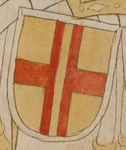
Or, a cross voided per pale gules.
BSB Cod.icon. 308 u, folio 221r
|
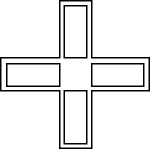
a cross couped contrevoided
|
|

Gules, a cross voided fleury.
BSB Cod.icon. 307, page 96
|
|
|
winged
|
The cross has wings, usually positioned as though they are growing
from its back.
|

a winged Latin cross couped
made with wings excerpted from Volume III of William Berry's 1828
Encyclopædia Heraldica, Plate XXVIII, Figure 5
|
The general practice of adding wings to inanimate objects in
heraldry is period.
(May,
2013 LoAR)
|




